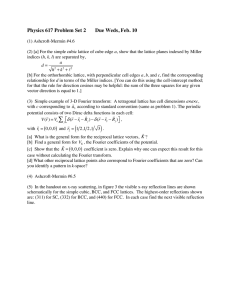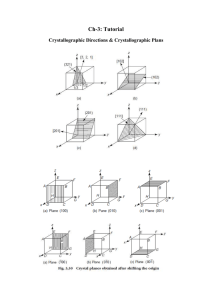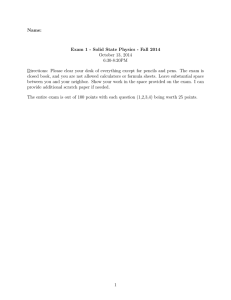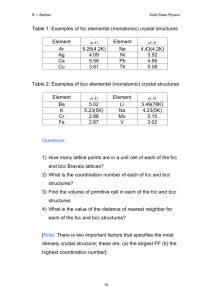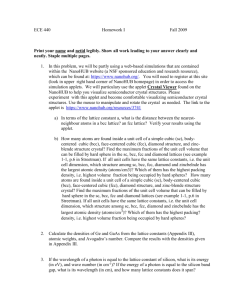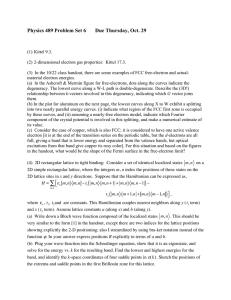22.14: Nuclear Materials, Spring 2015 Topic: Structure and Symmetry Purpose Problem Set 2
advertisement
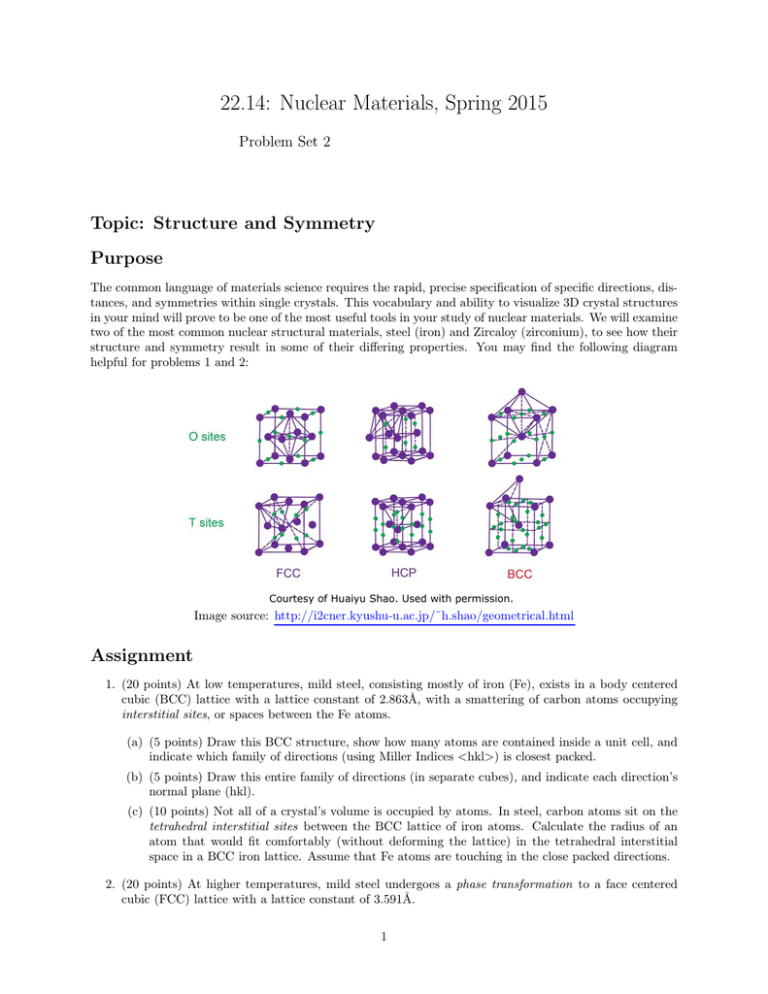
22.14: Nuclear Materials, Spring 2015 Problem Set 2 Topic: Structure and Symmetry Purpose The common language of materials science requires the rapid, precise specification of specific directions, distances, and symmetries within single crystals. This vocabulary and ability to visualize 3D crystal structures in your mind will prove to be one of the most useful tools in your study of nuclear materials. We will examine two of the most common nuclear structural materials, steel (iron) and Zircaloy (zirconium), to see how their structure and symmetry result in some of their differing properties. You may find the following diagram helpful for problems 1 and 2: Courtesy of Huaiyu Shao. Used with permission. Image source: http://i2cner.kyushu-u.ac.jp/˜h.shao/geometrical.html Assignment 1. (20 points) At low temperatures, mild steel, consisting mostly of iron (Fe), exists in a body centered cubic (BCC) lattice with a lattice constant of 2.863Å, with a smattering of carbon atoms occupying interstitial sites, or spaces between the Fe atoms. (a) (5 points) Draw this BCC structure, show how many atoms are contained inside a unit cell, and indicate which family of directions (using Miller Indices <hkl>) is closest packed. (b) (5 points) Draw this entire family of directions (in separate cubes), and indicate each direction’s normal plane (hkl). (c) (10 points) Not all of a crystal’s volume is occupied by atoms. In steel, carbon atoms sit on the tetrahedral interstitial sites between the BCC lattice of iron atoms. Calculate the radius of an atom that would fit comfortably (without deforming the lattice) in the tetrahedral interstitial space in a BCC iron lattice. Assume that Fe atoms are touching in the close packed directions. 2. (20 points) At higher temperatures, mild steel undergoes a phase transformation to a face centered cubic (FCC) lattice with a lattice constant of 3.591Å. 1 (a) (5 points) Draw this FCC structure, show how many atoms are contained inside a unit cell, and indicate which family of directions (using Miller Indices <hkl>) is closest packed. (b) (5 points) Draw this entire family of directions (in separate cubes), and indicate each direction’s normal plane (hkl). (c) (10 points) When steel phase transforms to FCC, the carbon atoms then occupy the octrahedral interstitial sites of the FCC structure. Calculate the radius of an atom that would fit comfortably (without deforming the lattice) in the octrahedral interstitial space in a FCC iron lattice. Assume that Fe atoms are touching in the close packed directions. 3. (15 points) Let us assume that we are studying the diffusion of carbon through steel at its phase transformation temperature, where both phases can co-exist. Within the same crystal system at different temperatures, the formula for a diffusion coefficient is governed by an Arrhenius relation: −EA D (T ) = D0 e RT where D0 is a prefactor, EA is the activation energy required for a carbon atom to jump interstitial sites in each crystal system, R is the ideal gas constant, and T is the temperature. Based on your calculations in (1) and (2) of the largest interstitial space in BCC and FCC lattices, draw a hypothesized, qualitative plot of the diffusion coefficient of carbon as a function of temperature in iron, including the phase transition temperature TBCC→FCC . Do not include numerical specifics, just draw what you think it would look like, and describe why. You may assume that D0 does not change, and EA is proportional to the ratio of the radius of a carbon atom divided by the radii in your answers to problems 1c and 2c rCarbon rCarbon , EAFCC = rproblem−2c for BCC and FCC iron, respectively. In mathematical terms: EABCC = rproblem− 1c 4. (15 points) The Fm3m space group, which describes austenite (FCC steel), contains a huge number of symmetry operators. One of these is a three-fold symmetry operator, along the [111] direction. See here for the space group. (a) (7 points) Draw a unit cell of this FCC structure, and draw the rotation axis in this unit cell. Construct the rotation matrix to transform an arbitrary point about this rotation axis. (b) (8 points) Show using this rotation matrix that the atomic locations in the FCC crystal lattice are indeed three-fold symmetric about the [111] axis. 5. (10 points) Show, using graphical arguments (by drawing unit cells), why a body-centered monoclinic Bravais lattice is equivalent to a base-centered monoclinic Bravais lattice. 6. (20 points) Zirconium exists in a hexagonal close packed (HCP) lattice, with a c/a axis ratio of 1.593. (a) (5 points) Draw the Zr lattice to scale. (b) (10 points) Draw all non-trivial symmetry operators in the Zr lattice. By non-trivial, we mean ignore 1-fold symmetry and simple translation. (c) (5 points) Compare the highest degree of proper (non-compound) symmetry operators in an HCP lattice with that of an FCC lattice. What do the highest degrees of symmetry suggest in terms of the ease of deformation in these two systems? 2 MIT OpenCourseWare http://ocw.mit.edu 22.14 Materials in Nuclear Engineering Spring 2015 For information about citing these materials or our Terms of Use, visit: http://ocw.mit.edu/terms.
